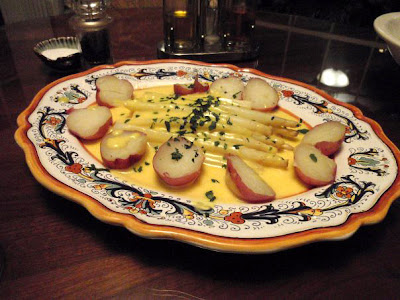A Springtime Roman treat, la vignarola is a vegetable 'medley' made from spring onions, fava beans, artichokes, peas and tender lettuce. It comes in an entirely vegan/vegetarian version and one that uses a bit of guanciale or pancetta to lend flavor.
You begin by lightly sautéing a bit of your cured pork meat in olive oil, just until translucent. Then add sliced fresh spring onions (scallions will do nicely as well), sauté for a minute or two, then add your artichoke, trimmed in the usual Italian manner and then sliced into wedges. Mix and continue to sauté for a minute or two longer. Then add fresh shelled fava beans and peas, season with salt and pepper, mix, and add some water to the pan. Cover and simmer gently until all your vegetables are nearly tender. Then add some tender lettuce (Boston or baby Romaine), finely shredded, and continue cooking until the lettuce has wilted and the vegetables are perfectly tender but not 'mushy'. As you prefer, you can cook off the liquid entirely or leave the dish rather 'brothy'. The exact cooking time varies according to the size and freshness of the vegetables but should take no more than 20-30 minutes at most. Serve either hot or, even better, at room temperature.
Once again, exact measurements are hardly that important, but try to balance the ratio of the main vegetable ingredients—artichokes, peas and fava beans—so they balance each other, so roughly equal amounts by weight of each should work well.
NOTES: While the above recipe is probably the most typical, as for so many traditional dishes, there are some variations on the theme. Some modern recipes get fancy and add that other typical, but more 'noble', springtime vegetable, asparagus. Some recipes call for the typical large Roman artichokes called mammole, similar to globe artichokes, but personally I like to use tender baby artichokes. Some recipes call for a bit of garlic in addition to the onion. I've seen one recipe that calls for a bit of peperoncino, it seems to me that would utterly overwhelm the delicate, sweet flavors of the spring vegetables. Some call for adding a bit of Roman mint called mentuccia or a few drops of lemon juice to 'brighten' the flavors. The amount of water varies from recipe to recipe. Some call for just a few drops of water—if necessary—to keep the vegetables moist. Personally, I like to add a fair amount of water to the pan and allow it to evaporate. I find that this melds the flavors more effectively and saves on the cooking time. Some recipes substitute broth or wine for the water, but I prefer the pure vegetable flavor you get from adding only water. As mentioned above, in some recipes, you serve your vignarola as a zuppa, still quite brothy, which makes for fine dipping with some crusty bread. Otherwise, you can let the liquid cook off and serve it perfectly 'dry'.
The dish is typically an antipasto, but it can serve as a light second course or, in its vegetarian version, even as a side dish.
La vignarola has a very short 'season' of only a few weeks while all the requisite vegetables are simultaneously in season. The dish is still good even if you're missing one of the ingredients (in fact, when I made it this time I didn't have the lettuce on hand.) But you can successfully use substitutes when one or more of the ingredients are out of season. Frozen peas are perfectly fine in lieu of fresh peas (just add them rather later in the cooking) and—believe it or not—edamame, even frozen edamame, are a fine substitute for fava beans, which can be hard to find in the US. And, in a pinch, you can use frozen artichokes. So, in fact, you can enjoy la vignarola more or less any time of year. But, of course, this dish is at its very best when you use all fresh, tender, young spring vegetables that the Italians call le primizie di primavera.
By the way, vignarola is also apparently the name of a kind of bruschetta topped with a lamb and cicoria mixture, an unusual antipasto that I found in a book called Le specialità della cucina romana: ricette tratte dalla tradizionale cucina casalinga. But by far the more common use of the word is for the recipe described above.
The word vigarola derives from 'vigna', or vine, since it is said that the vegetables that go into it were typically grown in between rows of grapevines.










